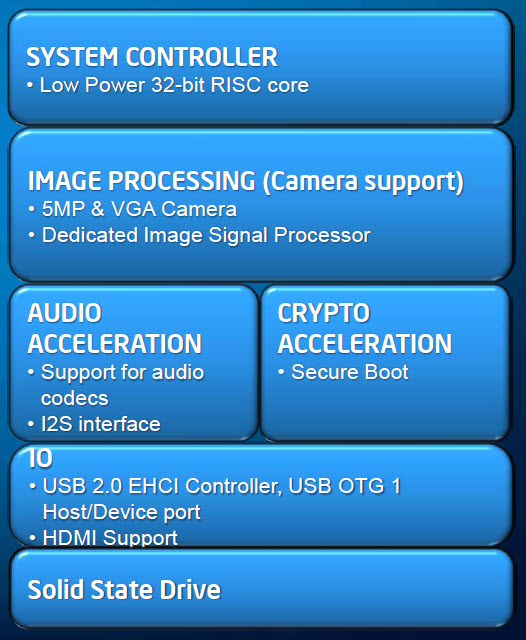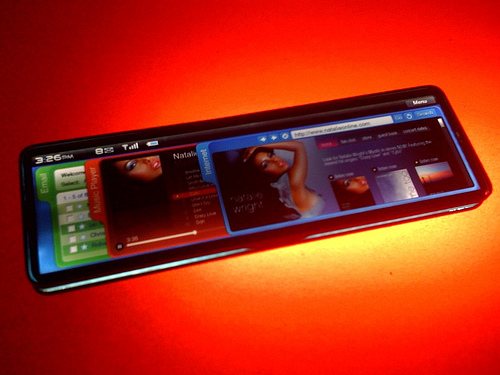Meet Moorestown: Intel's Atom Platform For The Next 10 Billion Devices
Intel’s second-gen Atom platform, Moorestown, positions the chip giant to have a killer smartphone and MID platform in 2010. The old Atom Z5xx drawbacks seem fixed. Why does Moorestown rock, and will it be enough to let Intel advance in this market?
Langwell Platform Controller Hub MP20
I said earlier that the MP20 chipset was pretty much an empty, downsized shell of its former Poulsbo self, reduced to being a collection of I/O blocks. That’s not exactly true. Yes, Intel builds a USB 2.0 EHCI controller with three ports into the 14 x 14 mm package. There’s also a USB On-the-Go (OTG) host/device port for letting the Moorestown ultramobile connect to other USB devices. Intel’s inclusion of HDMI support is all but overlooked in the Moorestown documentation, but its presence is obviously a key point for those who would like to use their devices as a video player for their TVs.
How about storage? There are four ports for SD/MMC/SDIO devices. More importantly, Langwell supports SLC and MLC NAND “drives” with up to 4KB page sizes and a raw capacity of 64GB. Note that while Langwell supports the CE-ATA spec common for 1-inch Microdrives, there’s no SATA connectivity. Most likely, the feature was considered unnecessary bloat given the part’s target applications. However, Intel does have implementation guidelines for developers that want to employ a third-party USB-to-SATA bridge. The same guidelines also detail how to connect a full-sized keyboard via an I2C interface.
Camera support and image processing also run through the MP20, both for still images and video. Moorestown allows for two cameras—one 5-megapixel and the other VGA (640x480) resolution. The 5MP channel is a dual-lane MIPI interface able to support RGB, YUV, and RAW color schemes, although how this capability gets exposed will be left to developers.
Langwell’s audio engine is more complex than you might expect. Intel uses its in-house Smart Sound Technology (SST), based on a 24-bit DSP, for voice processing and audio codec accelerations. Specifically, Langwell provides hardware-based encode acceleration for AAC-LC and PCM (WAV). On the decoding side, there’s hardware acceleration for AAC-LC, HE-AAC, MP3, PCM, and WMA9. This optimization, along with other elements of Langwell power management, is part of how Intel is able to hit its week-long MP3 playback time target. When the audio engine needs system resources, it generates a power management event, but only the path to memory is enabled. The audio engine refreshes the buffer and the platform quickly returns to its low power state.
While arguably less of a concern for consumers than businesspeople, some will be interested in Langwell’s integration of a security and cryptography engine, which includes the functionality of a Trusted Platform Module (TPM) chip. Intel accelerates AES, DES, 3DES, RSA, and other crypto operations, but the real benefit lies in enabling a secure boot environment, as with vPro systems. This is likely to become increasingly important as mobile devices become a larger target for malware and hijacking. Of course, content providers are keen on the ways in which DRM can be enforced with a security engine, as well.
Get Tom's Hardware's best news and in-depth reviews, straight to your inbox.
Current page: Langwell Platform Controller Hub MP20
Prev Page Display And Memory Next Page Briertown Mixed Signal IC-
yannifb Huh, i wonder how this will compete with Bobcat, which supposedly will have 90% of desktop chip performance according to AMD.Reply -
descendency Why isn't this a 32nm product yet? If your concern (which it would be with said devices) is power consumption, shrinking the die can only help...Reply -
Greg_77 silverx75Man, and the HTC Incredible just came out....Man, and I just got the HTC Incredible... ;)Reply
And so the march of technology continues! -
well we can only wait till amd gets their ULV chips out with their on die graphics so we can get a nice comparison.Reply
-
williamvw descendencyWhy isn't this a 32nm product yet? If your concern (which it would be with said devices) is power consumption, shrinking the die can only help...Time to market. 45 nm was quicker for development and it accomplished what needed to get done at this time. That's the official answer. Unofficially, sure, we all know 32 nm will help, but this is business for consumers. Right or wrong, you don't play all of your cards right away.Reply
-
seboj I've only had time to read half the article so far, but I'm excited! Good stuff, good stuff.Reply -
burnley14 This is more exciting to me than the release of 6-core processors and the like because these advances produce tangible results for my daily use. Good work Intel!Reply -
ta152h Do we really need x86 plaguing phones now? Good God, why didn't they use a more efficient instruction set for this? Compatibility isn't very important with the PC, since all the software will be new anyway.Reply
I like the Atom, but not in this role. x86 adds inefficiencies that aren't balanced by a need for compatibility in this market.

